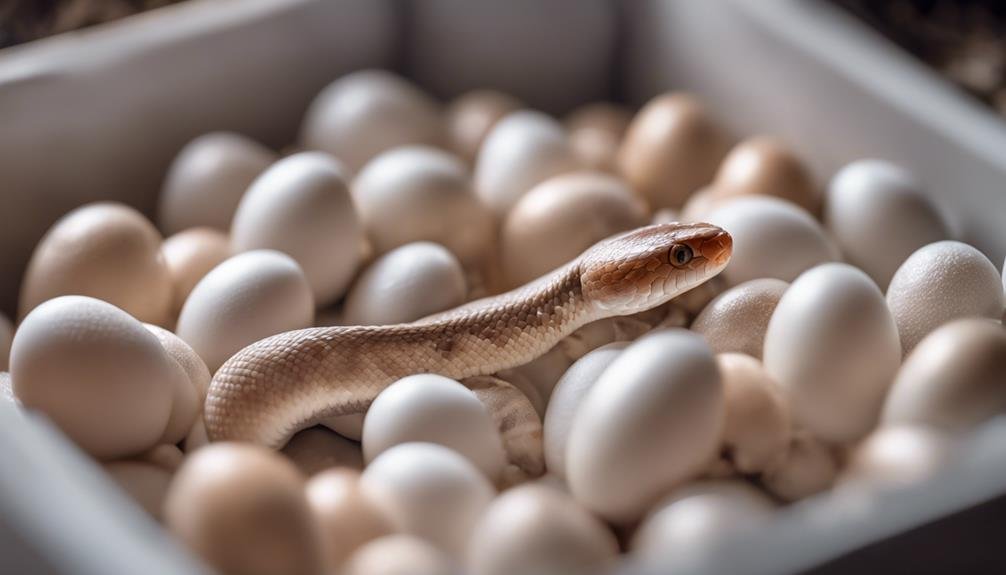If you’re venturing into the world of corn snake breeding, understanding the intricacies of incubating their eggs is pivotal for ensuring the emergence of healthy hatchlings. You’ll need to master the balance of vermiculite and water, maintain the perfect temperature and humidity, and select the appropriate substrate. This journey requires precision, from collecting the eggs to the moment they hatch. But how exactly do you turn this knowledge into successful hatchlings, and what are the common pitfalls to avoid? Let’s explore the critical steps and techniques to make or break your breeding success, ensuring you can navigate the challenges ahead.
Key Takeaways
- Maintain optimal incubation temperature between 78-82°F to ensure proper embryo development.
- Use a 1:1 ratio of vermiculite to water by weight for ideal humidity.
- Place eggs gently in the incubator without burying them, keeping them upright to prevent embryos from sticking.
- Monitor humidity and temperature regularly, adjusting conditions to maintain a steady environment.
- Candle eggs periodically to check for healthy embryo development and address any issues promptly.
Understanding Corn Snake Breeding
Exploring corn snake breeding is a complex process that hinges on pairing specific morphs like Amelanistic and Snow to explore the fascinating world of genetic traits and outcomes. Corn snakes, with their various colors and patterns, offer a unique canvas for breeders aiming to produce specific morphs or hybrids.
The breeding process starts with understanding the genetic makeup of your snakes, whether working with pure bloodlines such as Okeetee or Sunrise morphs or experimenting with combinations to reveal new patterns and colors.
As you investigate further, you’ll learn that successful breeding doesn’t just stop at pairing; it extends into the incubation process, where the careful management of eggs determines the health and viability of the hatchlings. In the warmth of the incubation environment, the future of your breeding efforts takes shape. Involving children in this process demystifies genetics and instills a sense of responsibility and wonder in the natural world.
Facing challenges in corn snake breeding is inevitable. From mastering husbandry skills to understanding the nuances of brumation and incubation, each step is critical. Yet, the rewards of witnessing the emergence of new life from carefully incubated eggs are unparalleled, making it a deeply rewarding experience.
Preparing the Incubation Environment
After mastering the basics of corn snake breeding, it’s time to focus on setting up the right incubation environment for your eggs. The success of your hatchlings depends heavily on the conditions within the incubator.
First, you’ll need to prepare the incubation medium. A 3:1 ratio of vermiculite and water provides the ideal substrate for corn snake eggs, balancing moisture without being overly wet.
Next, temperature and humidity are important factors. You must maintain humidity levels between 80% and 100% throughout the incubation to ensure the eggs don’t dry out. Similarly, keeping a constant temperature between 28-30 degrees Celsius is essential for optimal development. This delicate balance can be achieved by adjusting the thermostat in your incubator and monitoring it regularly to prevent fluctuations.
Lastly, when placing the eggs, gently bury them halfway into the vermiculite to mimic their natural nesting conditions. This helps maintain the right humidity around each egg and prevents it from rolling, ensuring it stays in the correct orientation for successful incubation.
Selecting the Right Substrate
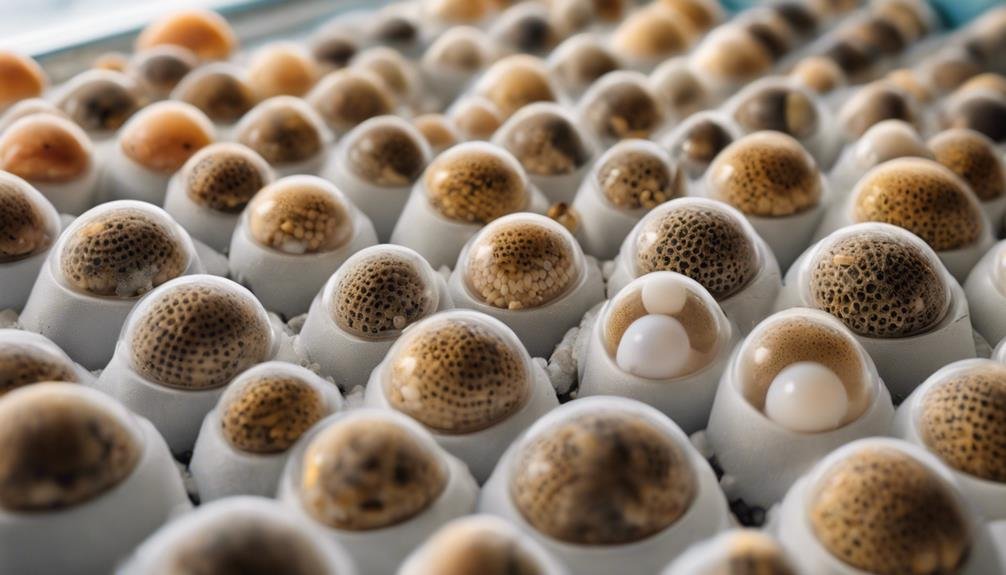

Selecting the right substrate when incubating corn snake eggs ensures the success of future hatchlings. Vermiculite and sphagnum moss are common substrates because they maintain essential humidity levels throughout incubation. Your substrate selection isn’t just an important detail—it’s foundational to the entire process.
The vermiculite-to-water ratio, typically 3:1, is essential for creating an environment that mimics the natural conditions eggs would experience in the wild. This ratio ensures the substrate retains enough moisture to prevent the eggs from dehydrating yet isn’t so wet that it encourages mold growth or other harmful conditions.
Remember, the incubation journey isn’t static. You’ll need to adjust and sometimes even change the substrate periodically to keep the moisture at an ideal level. This step is crucial as maintaining proper humidity levels is essential for the eggs’ development.
Choosing the right substrate and managing it carefully throughout the incubation period will greatly increase your chances of welcoming healthy corn snake hatchlings into the world. It’s a delicate balance, but with careful attention, you’ll set the stage for a successful hatching.
Egg Collection Techniques
Gathering corn snake eggs requires a vital touch to avoid causing any harm. Once your snake has laid eggs in the nesting box, you must be especially cautious during collection. It’s important to carefully handle each snake egg to prevent any damage that could affect the embryo.
After collecting the eggs, place them upright in an egg box prepared for incubation. This positioning is key to their successful development. Remember, burying corn snake eggs in the incubation medium is a mistake you’ll want to avoid. They require air exchange, and burying them can impede this process, leading to potential developmental issues.
Additionally, make sure that there’s no contact between the eggs in the egg box. Allowing them to touch can result in damage or fungal growth that might spread from one egg to another, jeopardizing the health of the entire clutch.
Setting Up the Incubator
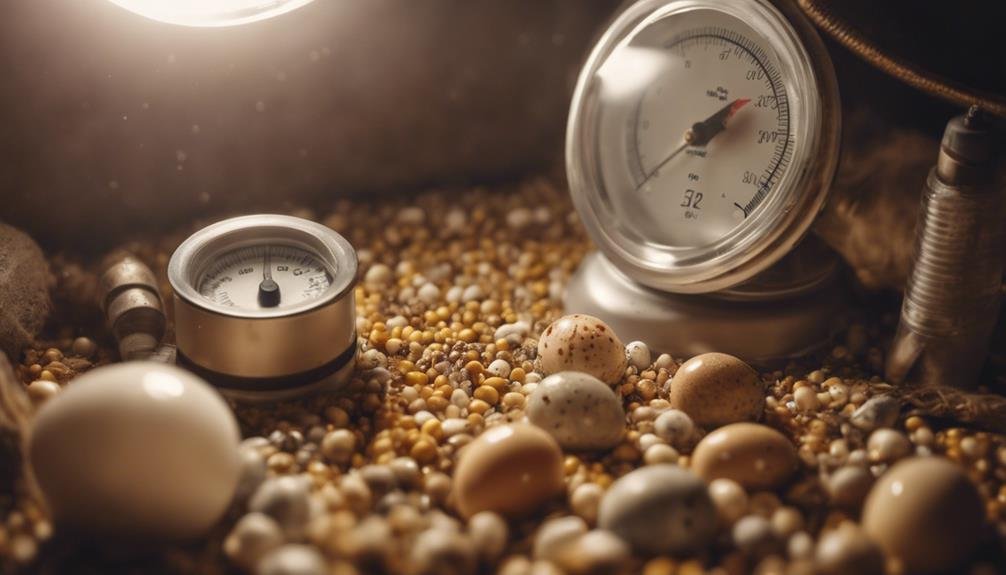

To guarantee the successful incubation of corn snake eggs, it’s important to set up your incubator properly and with precise temperature control. Start by choosing an incubator with heating and cooling functions to maintain a steady environment. This feature is vital as it allows you to set the temperature to 84 degrees Fahrenheit, ideal for corn snake egg incubation. Popular incubators like the Lucky Reptile Herp Nursery II and Exo Terra models are excellent choices due to their reliability and precision.
Before placing your egg box inside, verify the incubator’s temperature accuracy. Room temperature gadgets often mislead, so consider using an additional thermometer inside the incubator for a double-check. This step ensures that the incubator’s readouts are accurate and that your eggs are incubating at the correct temperature. A precise setup prevents the risk of overheating or undercooling, which could jeopardize the development of the embryos.
- Clutch and Egg Basics: Corn snakes typically lay a clutch of eggs, which can range in number. Each egg should be handled carefully to avoid issues during the incubation process.
- Egg Structure and Development: Corn snake eggs have a leathery shell and require specific conditions to develop properly. Understanding the development stages is crucial for ensuring the health of the hatchlings.
Incubation Temperature
- Optimal Temperature Range: Maintaining the right temperature is vital for successful incubation. The ideal incubation temperature for corn snake eggs is between 78-82°F (25-28°C). Use a reliable thermometer to monitor and adjust the temperature as needed.
- Methods for Temperature Control: Various methods exist for controlling temperature, including incubators or homemade setups. Ensure that the temperature is stable and within the recommended range.
Temperature and Humidity Control
Ensuring the correct balance of temperature and humidity is essential for the health of your corn snake eggs during incubation. For successful corn snake egg incubation, you must maintain a precise temperature range of 78°F to 89°F. This narrow window optimizes egg viability, promoting the development of healthy hatchlings. At the same time, humidity levels should be kept between 80% to 100% throughout the incubation period. Such high humidity is critical for preventing the eggs from drying out and providing the right environment for them to develop properly.
- Temperature Control: Keep the incubator within the ideal temperature range. Use reliable thermometers to monitor the temperature closely, adjusting as necessary to maintain consistency. This is essential to prevent deformities or mortality among the eggs.
- Humidity Levels: Use hygrometers to ensure humidity stays within the range of 80% to 100%. Adjusting water levels or ventilation can help manage these levels effectively.
- Monitoring for Egg Viability: Regular checks and adjustments based on the eggs’ development are crucial. If temperatures fluctuate outside the ideal range, act quickly to correct them to ensure the health of the hatchlings.
The Importance of Egg-Turning
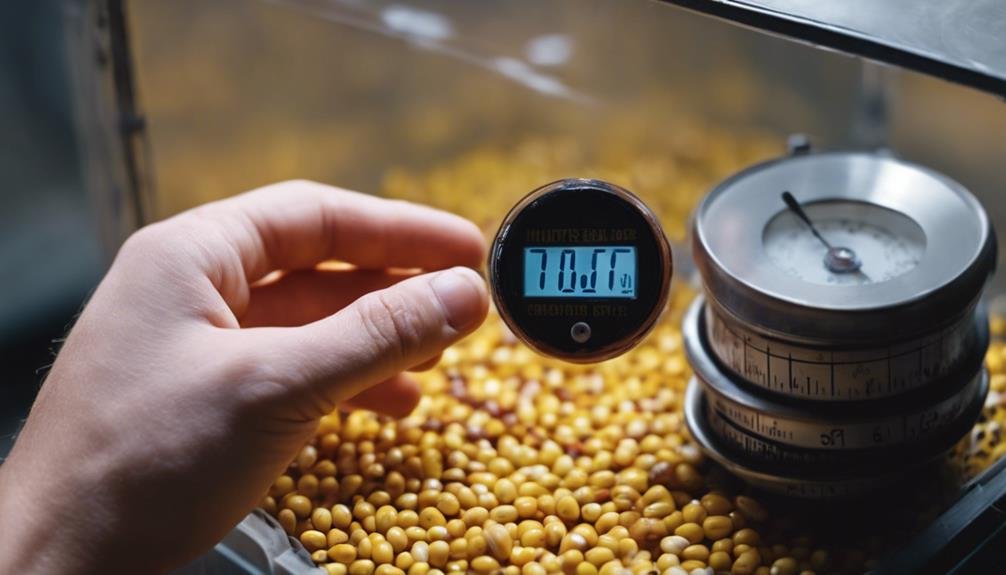

Just as the mother snake instinctively turns her eggs, you’ll need to regularly rotate yours to prevent the embryos from sticking to the shells and guarantee their healthy development. This practice of egg turning isn’t just a whimsical step in the incubation process; it’s a critical action that mimics the instincts of the nesting female snake. Turning the eggs multiple times daily ensures that the heat within the incubator is evenly distributed, promoting the embryo’s healthy development.
Lack of egg turning can lead to serious issues. Without this consistent movement, the embryo may adhere to the membrane inside the egg, which can cause deformities or developmental problems in your hatchlings. It’s not just about preventing embryo sticking; it’s about providing the best conditions for the embryos to grow and thrive.
Monitoring Development Through Candling
After mastering the art of egg turning, the next step in overseeing the health of your corn snake’s developing embryos is learning how to candle the eggs effectively. Candling is a technique where you shine a light through the egg in a dark room, giving you a window into the otherwise hidden process of embryo growth and blood vessel formation. This method, typically done around day 5-7 of incubation, allows you to monitor the embryo’s health without disturbing its environment too much.
When you candle the eggs, here’s what you’re looking for:
- Clear visibility of veins: This is a sign of healthy embryo development. The intricate network of blood vessels should be visible, indicating that the embryo is growing as expected.
- Progression of embryo growth: Over time, you should notice changes in the size and shape of the embryo, a good sign that development is on track.
- Detection of potential issues: Dark spots or a lack of visible development may indicate infertility or other problems, signaling that the egg mightn’t hatch.
Regular candling provides invaluable insights into the incubation progress, ensuring you’re well-informed about the well-being of your future hatchlings.
Addressing Common Incubation Challenges
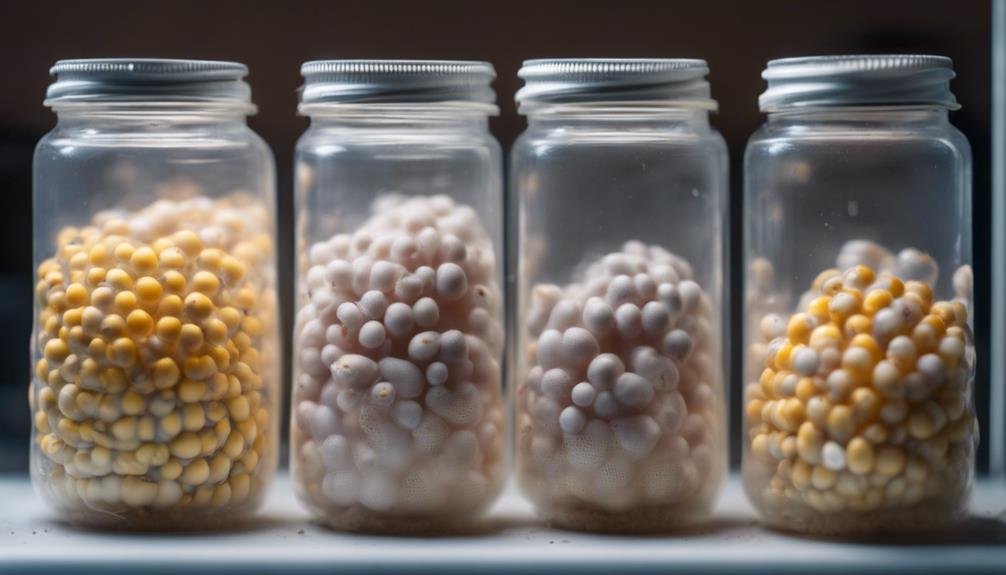

Maintaining ideal humidity levels and precise temperature regulation are crucial for incubating corn snake eggs.
You must adjust your incubator’s settings to keep the environment within the perfect range, ensuring your eggs have the best chance at healthy development.
Addressing these challenges promptly can make a significant difference in the success of your incubation efforts.
Humidity and Substrate
- Humidity Levels: Humidity plays a significant role in the incubation process. Aim for a humidity level of around 80-90%. A hygrometer can help you keep track of humidity levels.
- Choosing the Right Substrate: Vermiculite and perlite are commonly used substrates for incubating snake eggs. They help maintain the right humidity and prevent mold growth. Ensure the substrate is moist but not overly wet.
Incubation Containers and Setup
- Selecting the Right Container: Use containers that provide a controlled environment. Egg boxes or reptile egg containers with proper ventilation and moisture retention are ideal.
- Setting Up the Incubator: Place the egg container in an incubator or a controlled environment that maintains the optimal temperature and humidity. Ensure the setup allows for air circulation and prevents overheating.
Hatching Process
- Monitoring Eggs: Regularly check the eggs for signs of hatching. Look for small cracks or changes in appearance. Do not disturb the eggs unnecessarily.
- Hatchling Care: Once the eggs hatch, provide the hatchlings with a suitable environment. Ensure they have access to water and appropriate food, such as small mice.
Troubleshooting Common Issues
- Dealing with Mold: If you notice mold growth, remove affected eggs immediately and adjust the humidity levels. Mold can harm the developing embryos.
- Addressing Temperature Fluctuations: Temperature fluctuations can impact egg development. Use a reliable thermostat or incubator with temperature stability features.
Maintaining Optimal Humidity Levels
Humidity levels between 80% and 100% during incubation are vital to guarantee the healthy development of corn snake eggs. A reliable hygrometer will be your best friend here, allowing you to measure and adjust the humidity inside your incubator accurately. If you notice the levels dipping, adding lukewarm water to the incubation medium can help boost the moisture to where it needs to be.
Here’s how you can ensure ideal humidity levels:
- Regularly check the hygrometer to monitor humidity levels.
- Add lukewarm water to the incubation medium as needed to maintain humidity.
- Avoid opening the incubator frequently, as this can lead to fluctuations in humidity levels.
Maintaining these conditions is vital for preventing egg desiccation and ensuring the healthy development of your corn snake hatchlings.
Temperature Regulation Techniques
Like maintaining ideal humidity levels, regulating the right temperature is key to successfully hatching corn snake eggs. To guarantee healthy development, keep the incubation environment within a strict temperature range of 78⁰ to 89⁰. However, avoiding the higher end of this spectrum is essential, as excessive heat can cause deformities or even mortality among the eggs. Aiming for more consistent temperature maintenance between 75⁰ to 80⁰ promotes ideal conditions for hatching.
Employing thermostats and redundant systems enables precise temperature control, greatly reducing the risk of losses. It’s important to monitor and adjust the temperatures regularly based on the viability of the eggs, ensuring each one has the best chance of developing into a healthy hatchling.
Hatching and Post-Incubation Care
When corn snake eggs near the 59-day mark, it’s important to monitor for signs of hatching, such as dimpling, to guarantee a successful emergence of the hatchlings. The journey from incubation to hatching is critical, with temperature playing a key role in ensuring the eggs develop properly and the hatchlings are ready to enter the world. It’s a delicate balance, but getting it right means you’ll soon see the rewards of careful monitoring and adjustments.
- Temperature Regulation: Maintaining a consistent temperature throughout the incubation and hatching process ensures the development and emergence of healthy hatchlings.
- Observation: Look for dimpling on the eggs, which signals that the hatchlings are about to emerge. This stage may take up to 2 days.
- Post-Hatching Care: Once the hatchlings fully emerge, they should be moved to individual enclosures to start their care outside the egg.
This process, from the final days of incubation to the care of the hatchlings, confirms the dedication required to raise corn snakes. Ensuring each step is meticulously carried out will lead to the young snakes’ successful hatching and healthy development.
Does the size of a corn snake affect the incubation process for their eggs?
The corn snake’s size and growth do not directly affect the incubation process for its eggs. Regardless of the snake’s length, the eggs require consistent temperature and humidity for successful incubation. However, larger snakes may produce more eggs, leading to a potentially longer incubation period.
Conclusion
You’ve begun a fulfilling journey in the incubation process for corn snake eggs. By grasping breeding techniques, preparing the environment, and selecting the right substrate, you’ve set the stage for success.
Remember, egg collection and setup are vital, as is the delicate art of egg turning. They monitor development through candling, which offers glimpses of the life you’re nurturing. Address challenges promptly and prepare for the joy of hatching.
With diligent care, you’re ensuring healthy hatchlings thrive. Welcome to the enchanting world of corn snake breeding!
Supportive Article
Signs of an Unhealthy Corn Snake Egg

